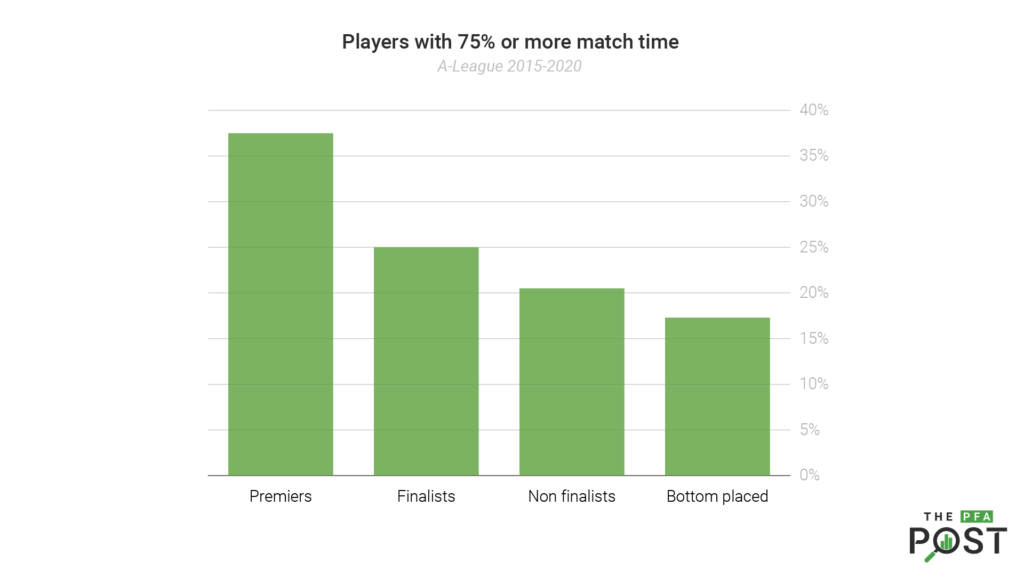In line with the PFA’s commitment to providing policy leadership to ensure Australian football is the best governed football nation in the world, is internationally competitive on and off the field and is a central part of Australian culture, ‘The PFA Post’ analyses issues impacting Australian football.
The link between contractual and squad stability and success has been revealed following an extensive examination of the past five seasons of the A-League in the latest edition of the PFA Post.
Highlighting once again the ineffectiveness of the current salary cap to promote competitive balance and contractual stability, the PFA’s research examined 1,403,281 A-League match minutes revealing a number of important trends ahead of the 2020/21 Season; including:
- the widening margin between the competition’s best and worst performing clubs;
- alarmingly, across the past four seasons of the A-League, clubs average 13.1 new players in their squads each season, with an average of 51% of their squad turned each year; and
- true success follows when the majority of a squad are playing 75% or more of the match minutes available over the course of a given season.
(Note: for the purpose of this research, match minutes played by players at expansion club Western United were not included)
🏅 A-League Ladder Position: 2015 – 2020
Sydney FC have finished first past the post in three of the past four seasons and only two other clubs – Adelaide United and Perth Glory – have taken Premiership honours in the analysis window.
Conversely, Central Coast Mariners have placed last in all but one of the past five seasons, with Newcastle Jets the only other club to have found itself at the foot of the table.
Based on finishing position, the Post ranks the clubs by tallying their respective table positions for each season, awarding maximum points to the first placed team (10 for finishing first) and a single point for the bottom placed team (1 for finishing last).
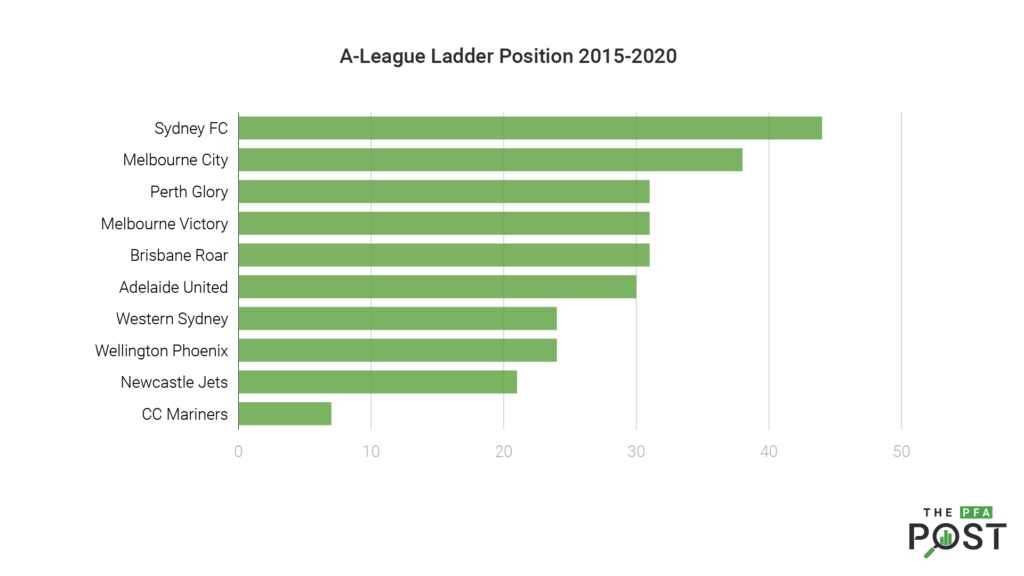
📈 League Success: The Broadening Gap
The gap between Sydney FC and Central Coast Mariners is 37 points, or in real terms, over seven rungs on the Premiership table. In a salary cap competition, the outcomes present a stark insight in the performance gap between top and bottom, while consolidating Sydney FC’s dominance since 2016.
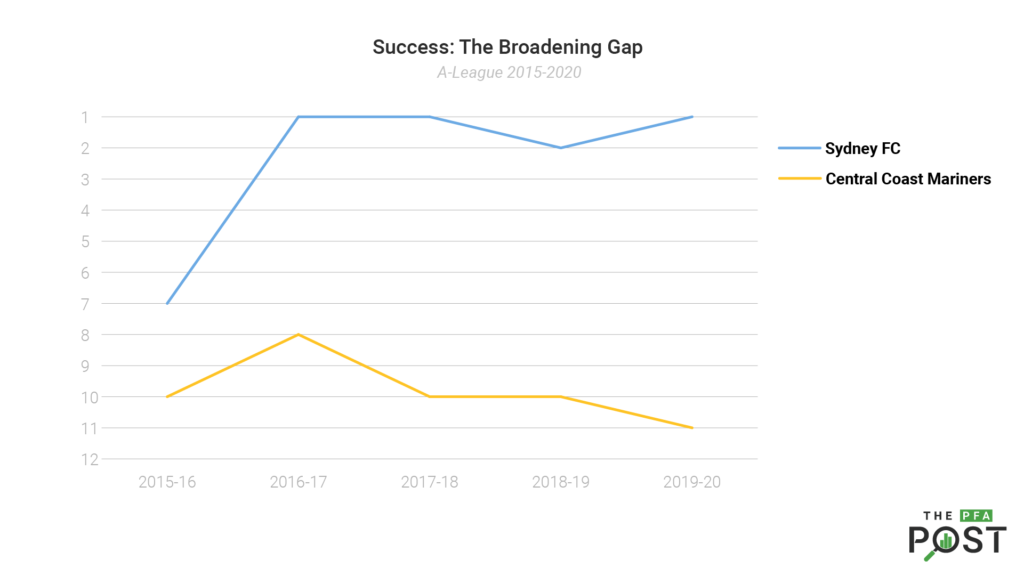
🔄 Players Used: Season Average
When you examine the number of players used by each club (on average) a correlation between those teams which have achieved the greatest success and the number of players they utilise to achieve it emerges. Fewer players used = greater squad stability.
Sydney FC are the standout in this instance, with an average of 22.4 players per season taking the pitch: two players fewer than the next best in Melbourne Victory and Wellington Phoenix.
The outlier in this data set is Melbourne City, and to a lesser extent, Western Sydney Wanderers; these clubs have invested heavily in youth development and have consistently provided opportunities for younger players to make their senior debut. In the case of City, this has done little to impact upon performance, with City the only club to appear in Finals in each of the past five years.
Wellington Phoenix also present as an abnormality; however, their emergence from ninth in 2015-16 to the club’s highest-ever finish last season (3rd) indicates the New Zealand-based club is profiting from a more consistent and stable squad over recent seasons.
♻️ Churn and Squad Turnover
The antithesis to squad stability is player churn. Alarmingly, across the past four seasons of the A-League, clubs average 13.1 new players in their squads and 51% of their squad is turned over on average each season. This directly affects each teams’ ability to build a squad that not only delivers success across the season, but also fails to build a meaningful connection with fans and build value that can realised in the international transfer market.
Alarmingly, both the number of new players in squads each season and the percentage of player turnover is trending upwards season on season.

Unsurprisingly, the team which has acquired the most success and produced the most stable squad, Sydney FC, has the lowest average of new players (10.25 new players) and second-lowest squad turnover (46%). However, even the Champions are losing close to half their squad at the end of each season due to squad turnover. At the other end of the spectrum, the Mariners, who experienced the highest level of churn of players in the 2018-19 season (69%) averaged 56% across the four seasons analysed (third highest).
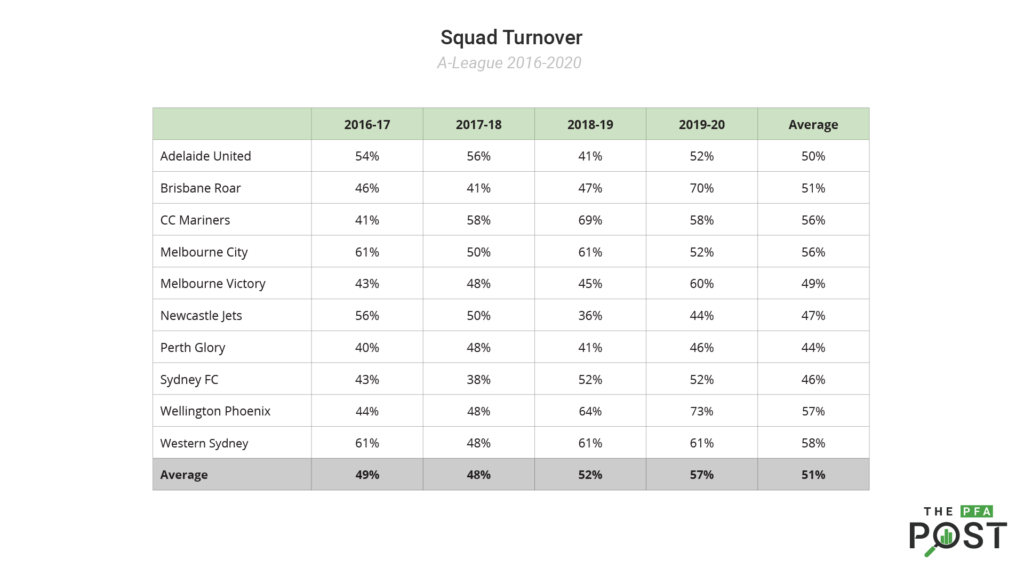
PFA research has consistently demonstrated that the current regulatory model is not fit for purpose. The salary cap encourages short-term contracting and discourages clubs to commit to long-term contracts, leading to more than half the A-League players coming off contract at the end of each season, meaning that churn – and movement of players across the league – is widespread, undermining the ability of clubs to build value in their players – and their chances of sporting success.
⏱️ Match Minutes
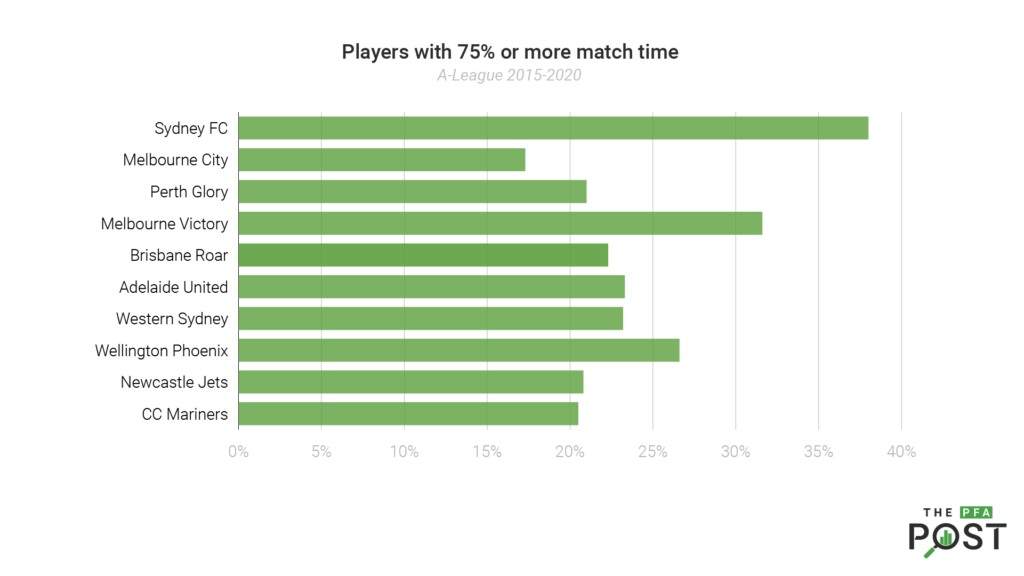
Using fewer players points to squad consistency, but true success follows when the majority of that squad are playing 75% or more of the match minutes available over the course of a given season.
Sydney FC are again a standout in this measure, with a season average of 38% of their squad achieving that target. Conversely, only one in every five players at the Mariners achieve this target, with 20.5% reflective of their position at the bottom of the table.
When you consider the respective finishing positions of each season, the Premiership teams (37.5%) and remaining finalists (25%) have significantly more players in this category than those finishing outside of the finals positions (20.5%) and at the foot of the table (17.3%).
